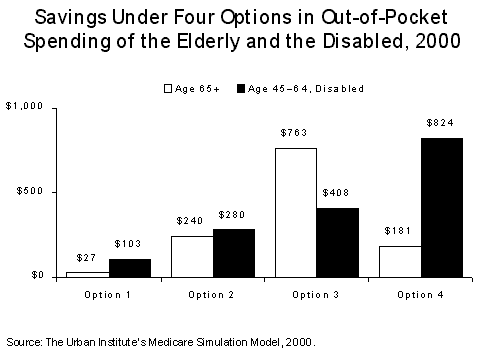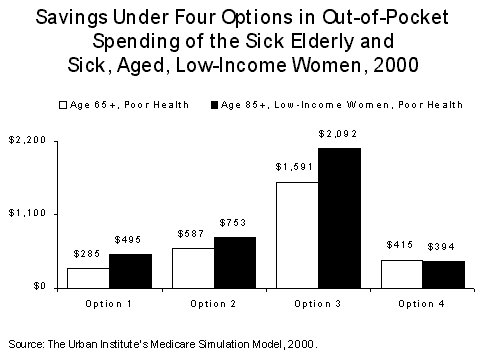A new Commonwealth Fund report presents a range of possible options for modernizing Medicare that would reverse spiraling costs for beneficiaries and reduce or eliminate the need for private supplemental insurance.
In Reforming Medicare's Benefit Package: Impact on Beneficiary Expenditures, Stephanie Maxwell, Marilyn Moon, and Matthew Storeygard of the Urban Institute analyze how beneficiary cost burdens would change under various options to expand Medicare's benefits.
"Medicare beneficiaries include many who are older widows living alone, some in nursing homes, some terminally ill, and some on modest incomes. All of their experiences must be taken into account when we discuss modernizing Medicare," said Karen Davis, president of The Commonwealth Fund. "By improving Medicare's benefit package we can reduce costs for all beneficiaries through the efficiencies of Medicare." Davis presented findings from the report today in Washington at a hearing of the House Ways and Means Health Subcommittee entitled "Strengthening Medicare: Modernizing Beneficiary Cost-Sharing."
 Three options examined in the report restructure deductible and premium costs to reduce costs to beneficiaries, especially those with high expenses (see attached table). Option 3 offers the greatest average decline in out-of-pocket spending¾and does so in a budget-neutral manner by having additional Medicare premiums substitute for costly Medigap premiums. Option 4 adds prescription drug coverage to the Medicare benefit. It could be added to any of the three benefit restructuring options, although at an additional cost to Medicare.
In addition to improving the benefit package, the analysis demonstrates that these options would result in out-of-pocket savings for all beneficiaries, who currently spend, on average, 22 percent of their income for health care. Option 3 lowers the share of income that elderly beneficiaries would spend out-of-pocket for their health care from 21.7 percent to 16.4 percent. Under all options, beneficiaries who are older, in poor health, and with low incomes would experience even greater savings; older, low-income women currently spend more than 50 percent of income on health care.
Three options examined in the report restructure deductible and premium costs to reduce costs to beneficiaries, especially those with high expenses (see attached table). Option 3 offers the greatest average decline in out-of-pocket spending¾and does so in a budget-neutral manner by having additional Medicare premiums substitute for costly Medigap premiums. Option 4 adds prescription drug coverage to the Medicare benefit. It could be added to any of the three benefit restructuring options, although at an additional cost to Medicare.
In addition to improving the benefit package, the analysis demonstrates that these options would result in out-of-pocket savings for all beneficiaries, who currently spend, on average, 22 percent of their income for health care. Option 3 lowers the share of income that elderly beneficiaries would spend out-of-pocket for their health care from 21.7 percent to 16.4 percent. Under all options, beneficiaries who are older, in poor health, and with low incomes would experience even greater savings; older, low-income women currently spend more than 50 percent of income on health care.
 The authors point out that the current Medicare benefit is clearly inadequate. About 90 percent of beneficiaries have additional coverage to make up for gaps, but these sources are becoming unstable and more expensive. Employer-sponsored supplemental insurance is declining for current retirees, and most employers have eliminated coverage for future retirees. Medigap insurance offers poor insurance value for increasingly high premiums, and the availability of Medicare Plus Choice, a managed care program with more comprehensive benefits, is declining.
"Costs to beneficiaries are often left out of the equation when Medicare budgets are analyzed, although it is critical to have a clear picture of how changes in Medicare will affect them," said Stephanie Maxwell, a researcher at the Urban Institute who coauthored the report. "Modernizing the Medicare benefit can indeed be accomplished to ensure that the program will continue to meet the health care needs of older and disabled Americans," added Marilyn Moon of the Urban Institute.
Reforming the Medicare Benefit Package: Four Illustrative Options
Option 1. Basic catastrophic coverage and restructured deductible
Option 1 combines Part A and Part B with a single annual deductible of $400 and a ceiling of $3,000 on beneficiary cost-sharing. This option would increase Medicare outlays by less than 2 percent in 2000.
Option 2. Additional catastrophic coverage and lower cost-sharing rates
Option 2 has a Part A deductible of $200 per spell of illness, a Part B annual deductible of $200, 10 percent coinsurance on physician and home health services, and a $2,000 ceiling on beneficiary cost-sharing. This option would increase Medicare outlays by an estimated 7 percent in 2000.
Option 3. Zero coinsurance and budget-neutral premium
Option 3 eliminates all deductibles and coinsurance, except for a $200 Part B deductible. Part B premiums are estimated to increase to a budget-neutral amount of $105 per month.
Option 4. Medicare prescription drug coverage
Option 4 adds a prescription drug benefit with 50 percent coinsurance, a $2,500 limit on beneficiary cost-sharing, and a $26 monthly premium. This option would increase Medicare spending by at least 6 percent in 2000. Note: Figures are expressed in 2000 amounts.
The authors point out that the current Medicare benefit is clearly inadequate. About 90 percent of beneficiaries have additional coverage to make up for gaps, but these sources are becoming unstable and more expensive. Employer-sponsored supplemental insurance is declining for current retirees, and most employers have eliminated coverage for future retirees. Medigap insurance offers poor insurance value for increasingly high premiums, and the availability of Medicare Plus Choice, a managed care program with more comprehensive benefits, is declining.
"Costs to beneficiaries are often left out of the equation when Medicare budgets are analyzed, although it is critical to have a clear picture of how changes in Medicare will affect them," said Stephanie Maxwell, a researcher at the Urban Institute who coauthored the report. "Modernizing the Medicare benefit can indeed be accomplished to ensure that the program will continue to meet the health care needs of older and disabled Americans," added Marilyn Moon of the Urban Institute.
Reforming the Medicare Benefit Package: Four Illustrative Options
Option 1. Basic catastrophic coverage and restructured deductible
Option 1 combines Part A and Part B with a single annual deductible of $400 and a ceiling of $3,000 on beneficiary cost-sharing. This option would increase Medicare outlays by less than 2 percent in 2000.
Option 2. Additional catastrophic coverage and lower cost-sharing rates
Option 2 has a Part A deductible of $200 per spell of illness, a Part B annual deductible of $200, 10 percent coinsurance on physician and home health services, and a $2,000 ceiling on beneficiary cost-sharing. This option would increase Medicare outlays by an estimated 7 percent in 2000.
Option 3. Zero coinsurance and budget-neutral premium
Option 3 eliminates all deductibles and coinsurance, except for a $200 Part B deductible. Part B premiums are estimated to increase to a budget-neutral amount of $105 per month.
Option 4. Medicare prescription drug coverage
Option 4 adds a prescription drug benefit with 50 percent coinsurance, a $2,500 limit on beneficiary cost-sharing, and a $26 monthly premium. This option would increase Medicare spending by at least 6 percent in 2000. Note: Figures are expressed in 2000 amounts.


